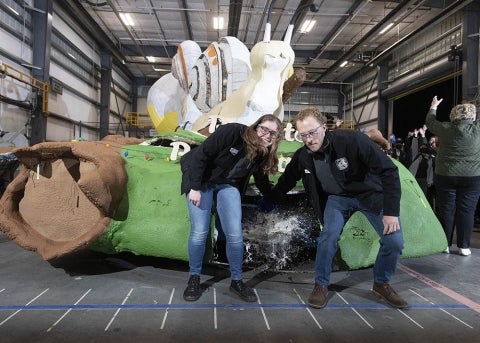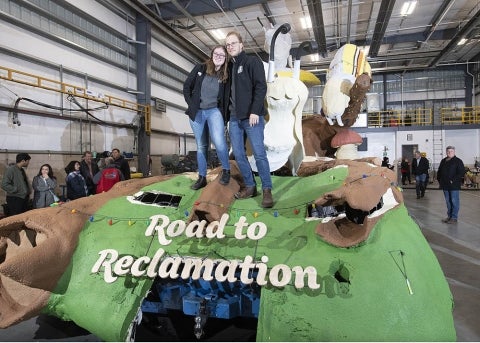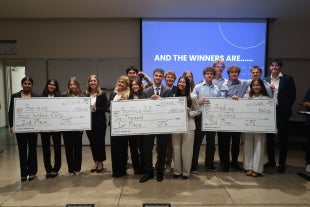Cal Poly Float Entry Gets an Early Slot in the 2023 Rose Parade®
Contact: Jay Thompson
805-756-5186 or 805-235-0955; jthomp04@calpoly.edu
Photos by Tom Zasadzinski | Cal Poly Pomona
SAN LUIS OBISPO — Cal Poly universities’ “Road to Reclamation” will be the first of the judged floats to roll down Colorado Boulevard on Jan. 2 at the 2023 Rose Parade® presented by Honda.
The parade has a “Never-on-Sunday” tradition when New Year’s Day falls on a Sunday. The entry, which follows the Rose Parade Opening Spectacular, parade sponsor Honda’s “Forever Determined” and the Marine Corps color guard and marching band, will be fourth overall in the lineup that includes 39 floats, 21 marching bands and 16 equestrian units.
“It is really, really exciting,” said team president Annie Doody, a marine sciences major from Glendale, of the parade slot. “It’s really cool to know that we’ll be one of the first things that people see during the parade. It’s going to help, pardon the pun, set the theme for the parade.”
This year’s floats reflect the theme of “Turning the Corner,” celebrating the unlimited potential that each new year brings.

“Whether that corner is actual or figurative like the unlimited potential that each new year brings — we all enjoy the opportunity of a fresh start,” said Amy Wainscott, the 2023 Pasadena Tournament of Roses president. “Turning a corner means rising above — alone, or with family, friends and community. This year … we share in the hope, beauty and joy of what 2023 will bring.”
“Road to Reclamation” takes a small scene in nature featuring snails and blows it up to gigantic proportions. Doody also hopes it will bring a smile with its whimsical illustration of the regenerative power of nature that the end of one phase of life can deliver to the next.
Snails are very important to their ecosystems. These gastropod mollusks (phylum Mollusca and the class Gastropoda) eat dead leaves on a forest floor and ultimately turn it into soil. In addition to creating soil, snails — terrestrial and aquatic — are a great food source for other creatures in the food chain.
Mechanical engineering student Benjamino Cruz, a four-year member of the Cal Poly team, submitted the original concept for “Road to Reclamation.” Cruz is the San Luis Obispo team’s construction chair who will be driving the float on this year’s 5-1/2-mile parade route.
“We wanted a concept that embodies being shrunk down to the size of a bug while being immersed in a lush, wooded forest floor,” Doody said. “A fallen branch is engulfed in a variety of exotic mushrooms, fun fungi and plentiful foliage will become host to a variety of creatures.”
Near the front of the 55-foot float, a snail devours a green leaf. Further up on an arched section the downed branch, a snail mom surveys her baby hanging underneath. On another part of the branch more baby snails chase each other. And towering about 25 feet above, perched atop a large, flat mushroom cap, another gastropod watches over the forest diorama that includes a trio of ladybugs daintily airing out their wings.
“All the creatures come together to create a thriving, beautiful ecosystem right beneath our feet,” Doody said.
The Rose Parade® features four types of entries: floral-decorated floats entered by a participating corporation, nonprofit organization or municipality; equestrian units; bands; and Tournament of Roses entries. Cal Poly’s float — the only student entry — also was given an early slot in the 2020 Rose Parade.
Participation in the parade is perhaps the highest-profile Cal Poly student project, and it has a wide international reach. Parade officials estimate that 700,000 people see the parade in person, while last year 28.5 million Americans and a worldwide audience estimated at 28 million watched it on TV. In 2022, viewers in 70 nations tuned in to the coverage.
“Our advisor likes to remind us all that in the parade we’re going to get Super Bowl-level viewership,” Doody said. “That’s how he puts it to get it into our heads that that many people are going to see it, which is always an exciting thing to think about. I know it, but I don’t think of what those implications are very often. To me, it’s like ‘We’re making a float, and it’s going to be really cool, and I’m personally going to feel very fulfilled.’ Then I remember that ‘Oh, my god! So many people are going to see this — and they’re going to know that’s what Cal Poly students did!’ ”

There’s one more major task looming, however.
On Dec. 19, the float was driven from Cal Poly Pomona to the Rosemont Pavilion located near the Rose Bowl in Pasadena. On the day after Christmas, both teams, aided by scores of volunteers working in shifts, will be covering the float in a variety of floral blooms and other organic materials during what they call Deco Week.
Work will continue through Jan. 1 when Rose Parade® judges will review the work, before the float is driven off to its starting spot in the parade. Awards will be announced about 6 a.m. on Jan. 2, just hours before the 8 a.m. start time.
Meanwhile, decorating shifts are still open and a waitlist is also taking names if preferred time and day aren’t available. Tasks vary, from processing flowers to delicate detail work, both on and off the float. All ages and skill levels are welcome to decorate (young children should be accompanied by an adult). For more details, visit https://www.eventbrite.com/o/cal-poly-rose-float-7536540057.



